Spring Newsletter 2023
We are seeing signs of spring everywhere, the increasing birdsong, unfurling leaves, emerging insects and blossoming hedgerows. It is perhaps the most exciting time of year, as we watch nature reawaken and the days lengthen.
Although the changing season is coupled with saying goodbye to many of our winter migrants such as brent geese, dunlin and wigeon, we are looking forward to soon greeting our summer visitors including swallows, nightjar and whimbrel.
Bird breeding season commences!
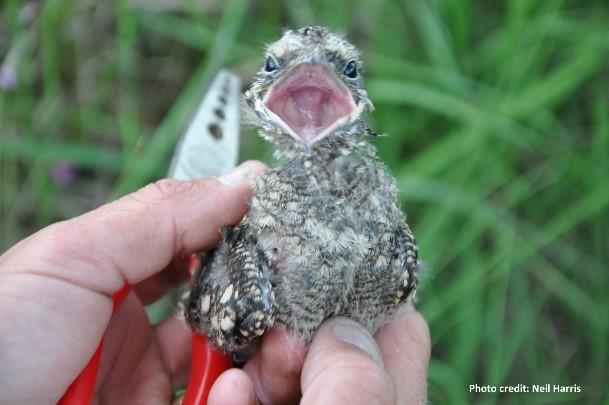
A nightjar chick being surveyed. Photo credit: Neil Harris
Bird breeding season has now officially begun (1st March - 31st July) so our team at South East Devon Wildlife shifts its priorities from the Exmouth Wildlife Refuge to breeding grounds on the Pebblebed Heaths and Dawlish Warren.
Although birds breed from January (e.g. crossbill) through to August (e.g. nightjar), March to July is the busiest time. Birds nest in a variety of ways, but the most vulnerable, tend to nest either on or very close to the ground.
On the Pebblebed Heaths, nightjar, which return to breed between April and May, nest amongst the heather and gorse. Here they lay their eggs directly onto the ground and use their bark-like camouflage to help them resemble a log. As you can imagine, this makes them particularly susceptible to disturbance from people and dogs, so now more than ever it is more essential for both you and your furry friends to stick to the paths! #PawsOnPaths
Nightjar are an internationally protected species and have suffered huge declines in the past however, their populations are now increasing. They migrate across great distances from Sub-Saharan Africa to the UK - it is now possible to track their journeys.
They are crepuscular, which means they are active at dawn and dusk and they make a rather distinctive churring call. If you’d like to see and hear nightjar, do keep an eye out for nightjar walks hosted by RSPB, Clinton Devon Estates and Wild East Devon.
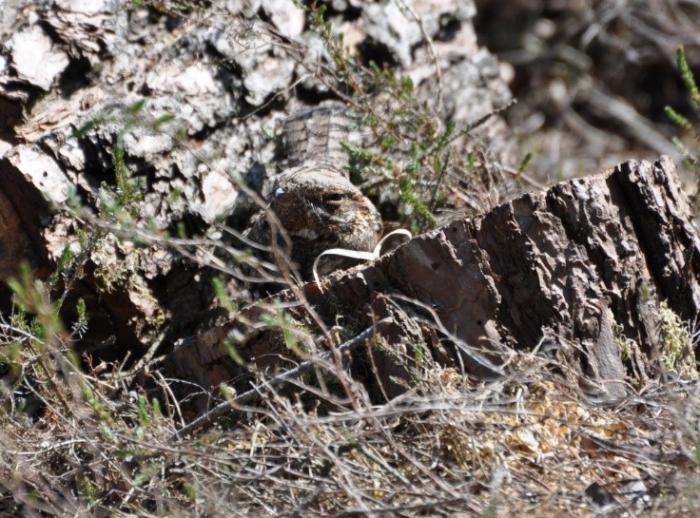
Nightjar camouflaged on a tree stump. Photo credit: Neil Harris
Winter swailing on the heaths
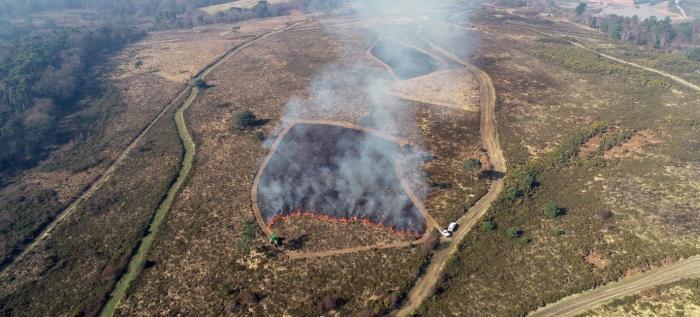
Aerial image of swailing on the Pebblebed Heaths.
You may have noticed recently that there has been an increased amount of burning on the Pebblebed Heaths. Swailing is the controlled burning of heathland. This creates a mosaic of habitats of all ages and variations, helping to support a greater variety of species and increasing the wildlife value of heathland.
This method of land management requires very specific conditions in order for it to be both safe and effective. Rangers will only swail through the winter (from November to end of February), as this is when there are low risks to wildlife – adders are safely hibernating and there are no eggs or chicks as breeding season has not yet begun. Also in the winter, the soil is damp enough to ensure the fire can remain under close control.
Only small patches of heathland are burnt each time, it is also made sure that sensitive areas, such as known Dartford Warbler territories, are avoided. A method called “back burning” is used, this involves creating a firebreak ring and starting a fire in front of its leeward (furthest away from the wind) edge. This method ensure the fire burns in a more controlled manner, against the wind.
After a particularly wet and windy start to this winter, the conditions were not suitable for swailing, as a fire would not be able to effectively stay alight. Therefore, the rangers waited until the end of January this year to begin swailing.
Swailing should not be confused with wildfires – it is carried out by experienced staff following strict guidelines. On the other hand, wildfires pose a real risk to wildlife, destroying the home and young of many vulnerable species.
Fires are not allowed on the Pebblebed Heaths and are illegal under the CROW Act unless undertaken by staff of the Conservation Trust. Please help us conserve the heaths by not having recreational fires or barbeques as these can quickly spiral out of control and cause lasting damage.
*If you see burning/smoke outside of swailing season, please report it immediately by dialling 999.*
Top tip: you can spot firebreak rings from Google Earth/Satellite across the Pebblebed Heaths to help you find previously swailed areas!
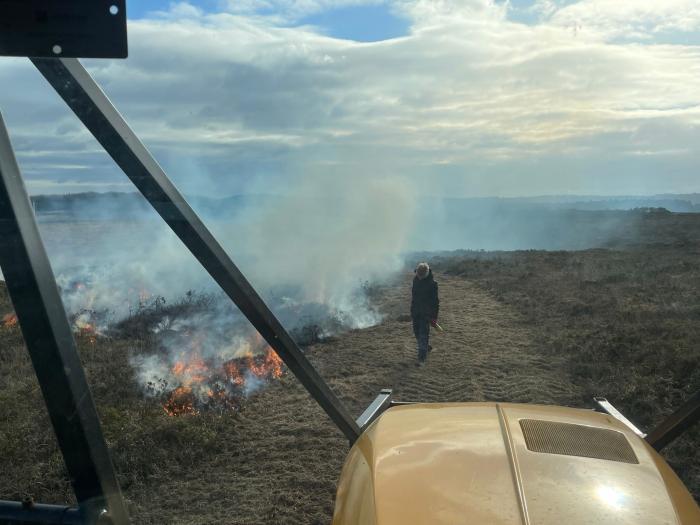
Februrary 2023 swailing on the Pebblebed Heaths. Photo credit: Ed Langdon
Small but special!
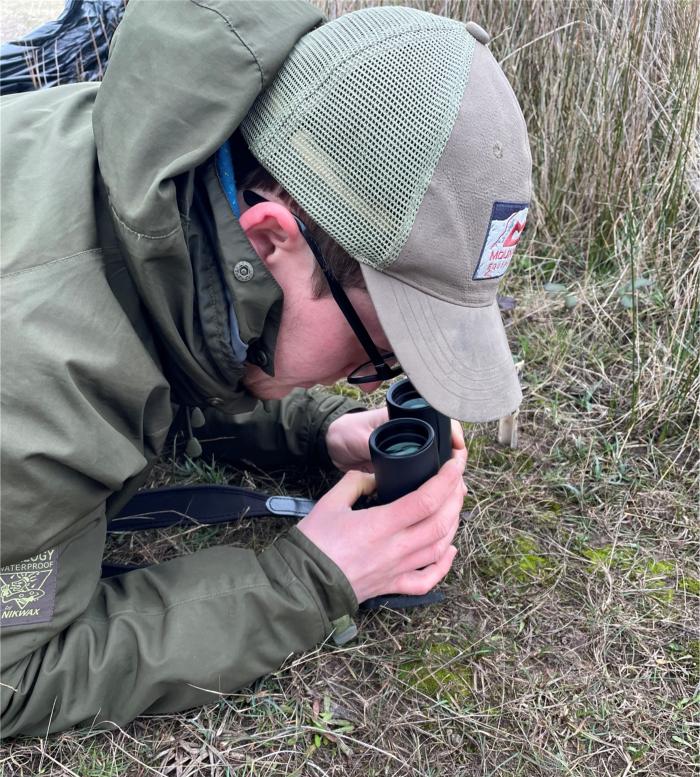
Dawlish Warren Ranger Caius looking for petalwort.
This time of year, you might see the rangers crawling on their hands and knees around the sand dunes, looking up close as if they have lost something. Fear not, they are just looking for the “most important individual species at the warren”, petalwort! This plant is one feature which makes Dawlish Warren internationally important as a Special Area of Conservation (SAC).
Petalwort is a tiny pale green plant which is nationally scarce in the UK, with Dawlish Warren being 1 of 7 sites in England where it is found. It is present in the Greenland Lake area, which is a humid dune slack; this habitat type is classified as “vulnerable” due to its scarce and declining status in Europe. At only approximately 5mm across, petalwort can be extremely difficult to find. If you’d like to see some, it is certainly helpful to have a magnifying glass to hand!
Each thallus (the above-ground part of the plant) is shaped like a miniature little gem lettuce and requires very specific conditions. Being so small, it thrives in areas where many other plants struggle, such as areas of compacted ground, which have been grazed or disturbed. This means that trampling is often a good thing for this plant, whereas over-stability is not (as other plants can crowd it out).
Usually petalwort is most visible from winter to early spring, however due to the warren’s high water table, it is best seen here in March. It is surveyed periodically in order to understand how its populations are doing, with the next survey being this month (March 2023).
Unfortunately, petalwort at Dawlish Warren could be significantly impacted by rising sea levels, with encroaching salt water affecting its current habitat. As a result, licensed translocation is scheduled for the end of March, where some plants will be moved from an area at risk of inundation from the sea, to a less vulnerable site at another, more protected area of Dawlish Warren.
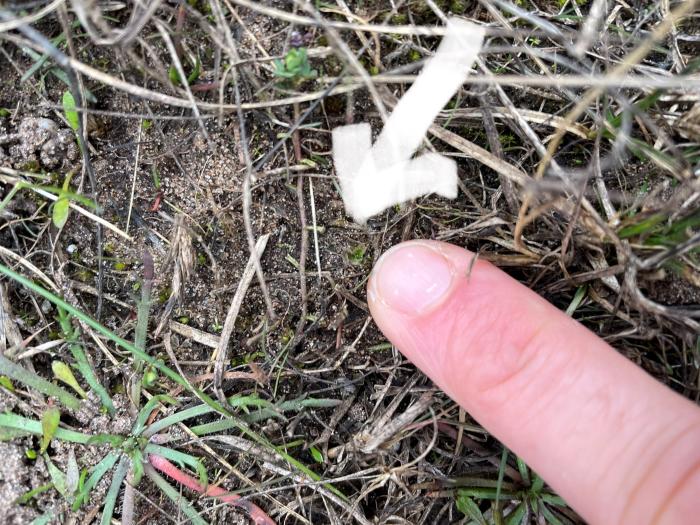
The scale comparison of petalwort to a fingernail.
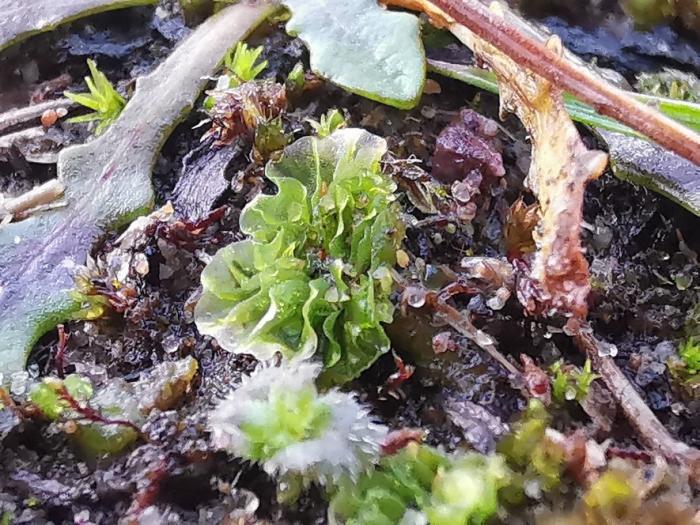
A close-up of petalwort. Photo credit: Phil Chambers
Join a waggy walk at Ridgetop Park
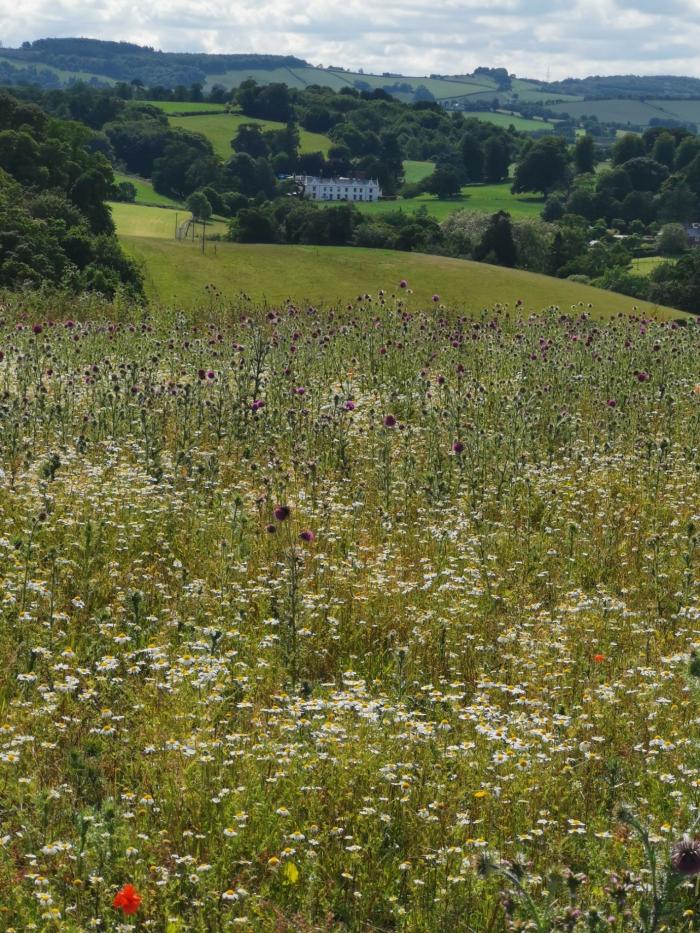
The wildflower meadows at Ridgetop Park. Photo credit: Neil Harris
Exminster residents have been enjoying the open space and the wonderful views from the Ridgetop Park since phase one opened last summer. Until now it has only been accessible for people walking and cycling to the Park but now there is limited car parking available.
On 29th March at 10am, Devon Loves Dogs will hold a waggy walk at the Park to help dog walkers understand how they can protect the wildlife on the Park, as well as allowing their dogs to run and play.
Cllr Geoff Jung, Chair of South East Devon Habitat Regulations Committee and Portfolio Holder for Coast, Country and Environment at East Devon District Council, said:
“We are thrilled that people can now enjoy the far reaching views over the Devon countryside and cathedral city of Exeter. The Park will help to protect wildlife by providing a new place for people to walk and enjoy the countryside which will help to reduce visitor numbers on nearby protected sites such as Dawlish Warren, the Exe Estuary and East Devon’s Pebblebed Heaths.”
The project has been achieved through the South East Devon Habitat Regulations Executive Committee – a partnership of Teignbridge, East Devon District and Exeter City Councils, and funding awarded through Devon County Council’s successful bid to the Government’s Housing Infrastructure Fund (HIF) for the South West Exeter Scheme.
Teignbridge District Council is leading on creating Ridgetop Park as a Suitable Alternative Natural Green Space (SANGS) which contributes to the partnership’s legal requirement to protect internationally important wildlife sites.
We are seeing signs of spring everywhere, the increasing birdsong, unfurling leaves, emerging insects and blossoming hedgerows. It is perhaps the most exciting time of year, as we watch nature reawaken and the days lengthen.
Although the changing season is coupled with saying goodbye to many of our winter migrants such as brent geese, dunlin and wigeon, we are looking forward to soon greeting our summer visitors including swallows, nightjar and whimbrel.
